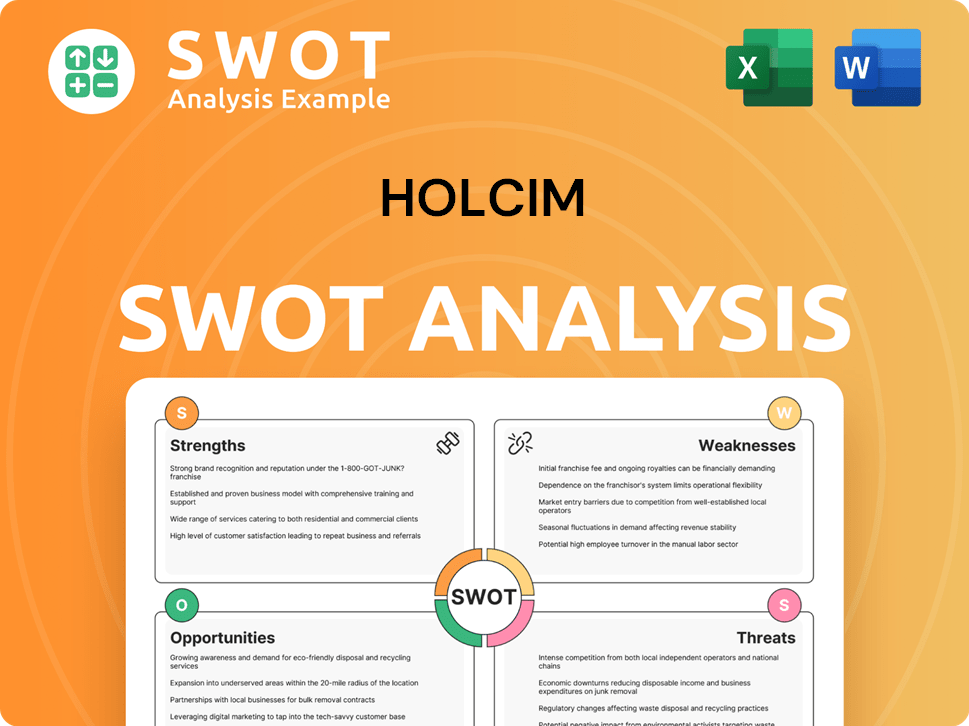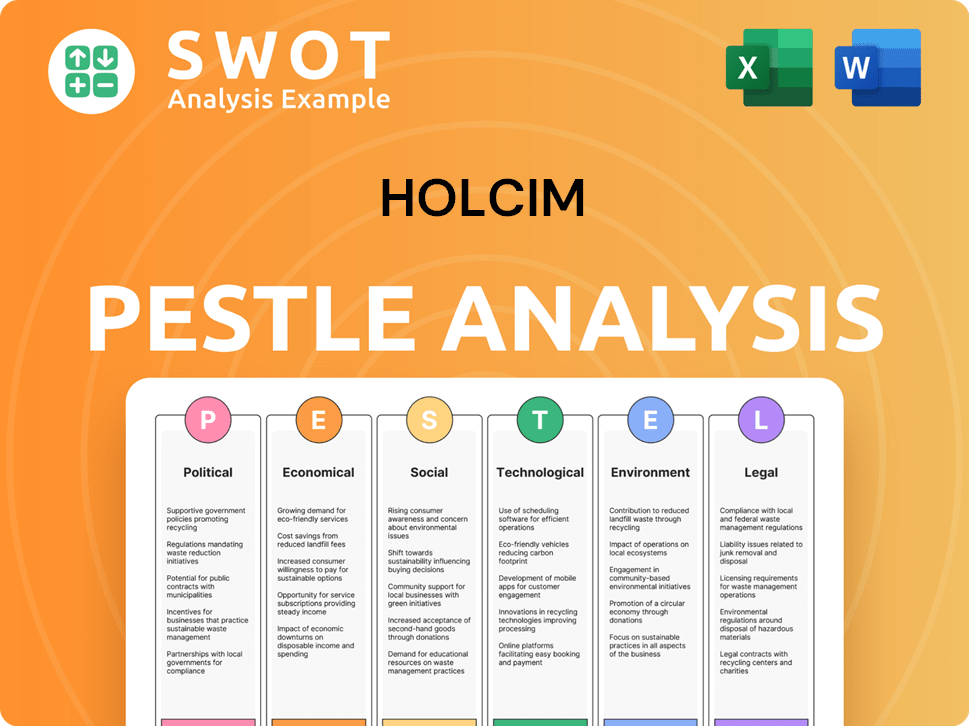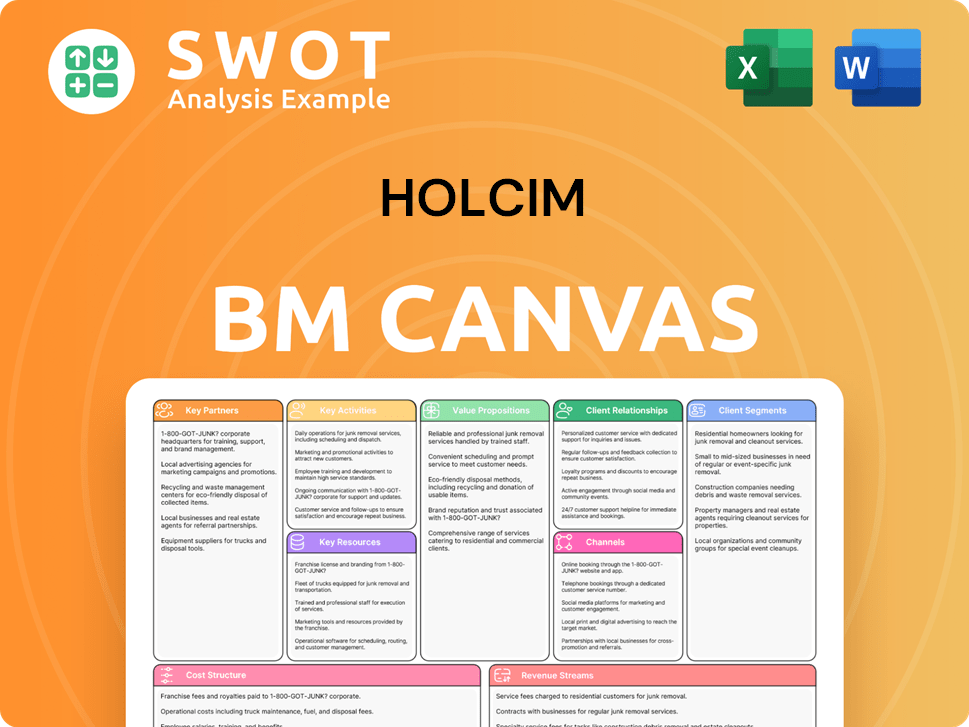Holcim Bundle
How Does Holcim Stack Up in the Global Construction Arena?
The construction materials sector is undergoing a massive transformation, fueled by tech and a push for sustainability. Holcim, a global leader with roots in Switzerland, is at the forefront of this evolution. With a planned North American business listing by mid-2025, understanding Holcim's competitive landscape is more crucial than ever.

From its humble beginnings, Holcim has become a powerhouse, constantly adapting and expanding its global footprint. This Holcim SWOT Analysis helps to understand its competitive advantages. The following analysis dives into the Holcim competitive landscape, exploring its rivals, market share worldwide, and strategic moves, providing a detailed Holcim market analysis within the dynamic cement market and the broader building materials companies sector. We'll examine Holcim's key strengths and weaknesses, its global presence and competition, and its response to industry challenges.
Where Does Holcim’ Stand in the Current Market?
Holcim's core operations revolve around supplying essential building materials, including cement, aggregates, and ready-mix concrete, globally. The company's value proposition centers on providing high-quality, sustainable building solutions that meet the evolving demands of the construction industry. This approach is supported by a commitment to innovation and a strategic focus on eco-friendly products.
The company's financial success in 2024 underlines its strong market position. With a record net sales of CHF 26.4 billion and a recurring EBIT of CHF 5.05 billion, Holcim demonstrates robust financial health. The company's industry-leading recurring EBIT margin reached 19.1%, highlighting its efficiency and profitability in a competitive market.
Holcim's competitive landscape is shaped by its diverse product offerings and global presence. Its strategic shift towards sustainable building solutions, such as ECOPact and ECOPlanet, further strengthens its market position. These eco-friendly products accounted for 36% of total net sales in 2024, showcasing a successful diversification strategy that aligns with the growing demand for green building materials. This strategic positioning gives Holcim a competitive advantage within the industry.
Holcim operates in around 60 countries, with significant presence across North America, Latin America, Europe, and Asia, Middle East & Africa. In North America, the company secured over 200 infrastructure projects. Latin America achieved its 18th consecutive quarter of profitable growth. Europe saw profitable growth driven by sustainable building solutions.
Holcim reported record full-year net sales of CHF 26.4 billion in 2024. Recurring EBIT reached a record CHF 5.05 billion, marking a 10.8% increase in local currency. The recurring EBIT margin expanded to 19.1%, reflecting strong financial performance. ECOPact and ECOPlanet contributed significantly to sales, reaching 36% of total net sales.
Holcim is focused on sustainable building solutions, with ECOPact and ECOPlanet leading the way. ECOPact accounted for 29% of ready-mix concrete net sales, and ECOPlanet represented 26% of cement net sales. These products demonstrate Holcim's commitment to reducing carbon emissions and promoting green building practices.
Holcim's competitive advantages include a strong global presence and a focus on sustainable building solutions. The company's financial performance, with a record EBIT margin, highlights its efficiency and profitability. Its strategic focus on eco-friendly products strengthens its market position and attracts environmentally conscious customers.
Holcim's strong market position is supported by its financial performance, geographic diversification, and strategic focus on sustainability. The company's success in North America, Latin America, Europe, and Asia, Middle East & Africa highlights its global reach and adaptability. The growth of ECOPact and ECOPlanet demonstrates its leadership in the green building materials market.
- Holcim's 2024 net sales were CHF 26.4 billion.
- Recurring EBIT reached CHF 5.05 billion.
- ECOPact and ECOPlanet accounted for 36% of total net sales.
- North America delivered a record recurring EBIT of CHF 1.624 billion.
Holcim SWOT Analysis
- Complete SWOT Breakdown
- Fully Customizable
- Editable in Excel & Word
- Professional Formatting
- Investor-Ready Format

Who Are the Main Competitors Challenging Holcim?
The Holcim competitive landscape is shaped by a diverse group of companies vying for market share in the building materials sector. Understanding these Holcim competitors is crucial for assessing the company's position and strategic moves. This analysis delves into the key players, their strategies, and the broader industry dynamics influencing Holcim's performance.
Holcim's market analysis reveals a complex web of direct and indirect rivals. These competitors employ various strategies to gain an edge, from product diversification to geographic expansion and technological innovation. The competitive environment is constantly evolving due to mergers, acquisitions, and the adoption of new technologies, requiring Holcim to adapt and innovate continuously.
Holcim faces competition from a range of significant direct and indirect players within the building materials sector. Key direct competitors include global giants such as Heidelberg Materials (formerly HeidelbergCement), CRH, and Cemex. Vulcan Materials Company and Martin Marietta Materials are also prominent rivals, particularly in the aggregates and construction materials segments. U.S. Concrete is another notable competitor in the ready-mixed concrete and aggregates supply.
Heidelberg Materials, a major manufacturer of building materials, competes directly across cement, concrete, and aggregates. CRH, a diversified building materials group, competes through its broad product portfolio and extensive geographic presence. Cemex also poses a significant challenge with its focus on cement, ready-mix concrete, and aggregates, particularly in Latin American markets.
Fastenal, which distributes industrial and construction supplies, and Geberit, specializing in sanitary products, represent indirect competition in broader construction-related offerings. The Home Depot, as a retailer of home improvement products, also represents an indirect competitor in certain segments of the market. Emerging players and technological advancements are also disrupting the traditional landscape.
The increasing adoption of modular construction, 3D printing, and sustainable building methods by various industry players indicates a shift in competitive dynamics. Mergers and acquisitions also continually reshape the competitive environment; for example, Holcim itself has been active in M&A, closing 27 transactions in 2024 to expand its presence in attractive markets.
The cement market and building materials companies are influenced by global construction trends, regional economic conditions, and government regulations. Sustainability initiatives and the demand for green building materials are increasingly important factors. Holcim's competitive advantages include its global presence, diversified product portfolio, and focus on innovation.
Holcim's financial performance compared to competitors is crucial for assessing its market position. Key metrics include revenue, profitability, market share, and return on investment. Recent data shows Holcim's commitment to expanding its presence, with acquisitions playing a significant role in its growth strategy. Holcim's revenue for 2024 reached approximately CHF 27 billion.
Holcim's future outlook in the construction industry is influenced by its ability to adapt to changing market conditions and technological advancements. Strategic alliances, geographic market segmentation, and pricing strategies are key factors. The company's response to industry challenges, including sustainability and digital transformation, will shape its competitive positioning.
Several factors influence the competitive landscape within the Holcim industry.
- Global Presence: Holcim's extensive geographic footprint allows it to serve diverse markets.
- Product Portfolio: A wide range of products, including cement, aggregates, and concrete, enhances competitiveness.
- Sustainability Initiatives: Focus on green building materials and sustainable practices is increasingly important.
- Innovation: Adoption of new technologies like 3D printing and modular construction.
- Mergers and Acquisitions: Strategic acquisitions to expand market share and enter new regions.
Holcim PESTLE Analysis
- Covers All 6 PESTLE Categories
- No Research Needed – Save Hours of Work
- Built by Experts, Trusted by Consultants
- Instant Download, Ready to Use
- 100% Editable, Fully Customizable

What Gives Holcim a Competitive Edge Over Its Rivals?
Analyzing the Growth Strategy of Holcim reveals a competitive landscape shaped by strategic initiatives and market dynamics. The company's approach is defined by its operational scale, diverse product offerings, and commitment to sustainability. This strategy allows it to maintain a strong position in the global building materials market.
The competitive advantages of Holcim are rooted in its extensive global presence and broad product portfolio. With operations in around 60 countries and a workforce of approximately 65,000 employees, the company benefits from economies of scale. This scale contributes to cost efficiencies that smaller competitors cannot match, providing a significant edge in the Holcim competitive landscape.
Holcim's strategic moves, including significant investments in sustainable building solutions and value-accretive acquisitions, further enhance its market position. These initiatives, coupled with its commitment to innovation, position it as a leader in the evolving construction industry. The company's focus on eco-friendly products and circular construction practices aligns with the growing demand for sustainable building materials, ensuring its relevance and resilience against competitors.
Holcim's global presence in approximately 60 countries and a workforce of around 65,000 employees allows for economies of scale. This scale enables cost efficiencies in production and distribution, providing a significant advantage over smaller competitors. This operational efficiency is a key factor in maintaining a strong position in the Holcim industry.
The company offers a broad range of products, including cement, aggregates, and ready-mix concrete, catering to diverse construction needs. Advanced solutions like roofing and insulation systems further diversify its offerings. This comprehensive portfolio allows Holcim to serve various end markets, from residential to large-scale infrastructure projects, which is a key aspect of Holcim's market analysis.
Holcim leads in sustainable building solutions with products like ECOPact and ECOPlanet. In 2024, these advanced branded solutions grew to 36% of total net sales. ECOPact reached 29% of ready-mix concrete net sales, and ECOPlanet accounted for 26% of cement net sales by the end of 2024. This focus on sustainability is a key differentiator in the Cement market.
Holcim strengthens its market position through strategic acquisitions, with 27 transactions closed in 2024. These acquisitions, such as OX Engineered Products, enhance its solutions and products segment. This expansion strategy supports its growth in attractive markets and enhances its competitive edge against Holcim competitors.
Holcim's competitive advantages include operational scale, a diversified product portfolio, and leadership in sustainable building solutions. The company's focus on innovation, particularly in eco-friendly products, and its strategic acquisitions further strengthen its market position. These strengths position Holcim well in the building materials companies sector.
- Extensive Global Presence: Operations in approximately 60 countries.
- Sustainable Solutions: ECOPact and ECOPlanet, contributing significantly to net sales.
- Strategic Acquisitions: 27 transactions closed in 2024, enhancing market reach.
- Circular Construction: Increased use of recycled construction demolition materials by 20% to 10.2 million tons in 2024.
Holcim Business Model Canvas
- Complete 9-Block Business Model Canvas
- Effortlessly Communicate Your Business Strategy
- Investor-Ready BMC Format
- 100% Editable and Customizable
- Clear and Structured Layout

What Industry Trends Are Reshaping Holcim’s Competitive Landscape?
The Holcim competitive landscape is significantly influenced by industry trends, future challenges, and strategic opportunities. Understanding these elements is crucial for assessing its market position and future prospects. This analysis will delve into the key factors shaping the building materials sector and how Holcim is positioned to navigate them.
The building materials industry faces both risks and opportunities. Economic conditions, technological advancements, and sustainability practices are key drivers. Holcim's ability to adapt to these changes will determine its success in the cement market and beyond. Recent data, including financial performance compared to competitors, will provide insight into Holcim's strategic direction.
Technological advancements, such as Building Information Modeling (BIM) and AI, are transforming design and project management. Sustainability is a major focus, with eco-friendly materials gaining importance. The green building industry is projected to reach $851 billion by 2028, indicating strong growth. The Brief History of Holcim provides context for its evolution within these trends.
Workforce shortages and skill gaps remain a concern for the construction industry. Supply chain disruptions and volatile material costs continue to pose risks. Stricter ESG regulations may increase material costs. Potential tariffs on imported materials and uncertain interest rates could also impact project budgets in 2025.
Holcim can capitalize on the rising demand for sustainable building solutions. The company's investments in decarbonization and circular construction position it well. Emerging markets and infrastructure modernization offer significant growth potential. The planned listing of its North American business, 'Amrize,' is expected to unlock value.
Holcim is concentrating on eco-friendly products and sustainable practices. The company is investing in value-accretive acquisitions, with 27 transactions in 2024. Holcim projects mid-single-digit net sales growth in local currency and an expansion of its earnings before interest and tax margin for 2025.
Holcim's competitive advantages are rooted in its focus on sustainability and strategic acquisitions. The company's eco-friendly products, like ECOPact and ECOPlanet, meet the growing demand for green building solutions. Holcim's investments in decarbonization and circular construction, including a 20% rise in recycled construction demolition materials to 10.2 million tons in 2024, further enhance its market position.
- Sustainable Products: ECOPact and ECOPlanet meet the growing demand for green building solutions.
- Decarbonization: Investments in reducing carbon footprint.
- Circular Construction: Utilizing recycled materials.
- Strategic Acquisitions: 27 transactions in 2024 to enhance growth.
Holcim Porter's Five Forces Analysis
- Covers All 5 Competitive Forces in Detail
- Structured for Consultants, Students, and Founders
- 100% Editable in Microsoft Word & Excel
- Instant Digital Download – Use Immediately
- Compatible with Mac & PC – Fully Unlocked

Related Blogs
- What are Mission Vision & Core Values of Holcim Company?
- What is Growth Strategy and Future Prospects of Holcim Company?
- How Does Holcim Company Work?
- What is Sales and Marketing Strategy of Holcim Company?
- What is Brief History of Holcim Company?
- Who Owns Holcim Company?
- What is Customer Demographics and Target Market of Holcim Company?
Disclaimer
All information, articles, and product details provided on this website are for general informational and educational purposes only. We do not claim any ownership over, nor do we intend to infringe upon, any trademarks, copyrights, logos, brand names, or other intellectual property mentioned or depicted on this site. Such intellectual property remains the property of its respective owners, and any references here are made solely for identification or informational purposes, without implying any affiliation, endorsement, or partnership.
We make no representations or warranties, express or implied, regarding the accuracy, completeness, or suitability of any content or products presented. Nothing on this website should be construed as legal, tax, investment, financial, medical, or other professional advice. In addition, no part of this site—including articles or product references—constitutes a solicitation, recommendation, endorsement, advertisement, or offer to buy or sell any securities, franchises, or other financial instruments, particularly in jurisdictions where such activity would be unlawful.
All content is of a general nature and may not address the specific circumstances of any individual or entity. It is not a substitute for professional advice or services. Any actions you take based on the information provided here are strictly at your own risk. You accept full responsibility for any decisions or outcomes arising from your use of this website and agree to release us from any liability in connection with your use of, or reliance upon, the content or products found herein.